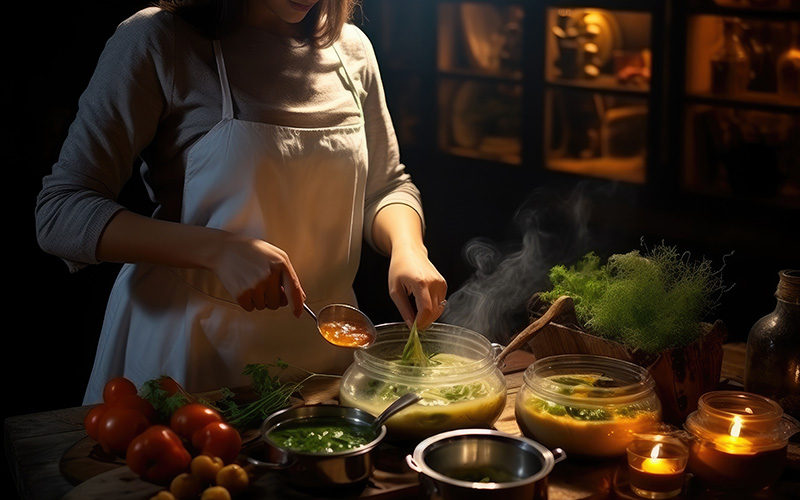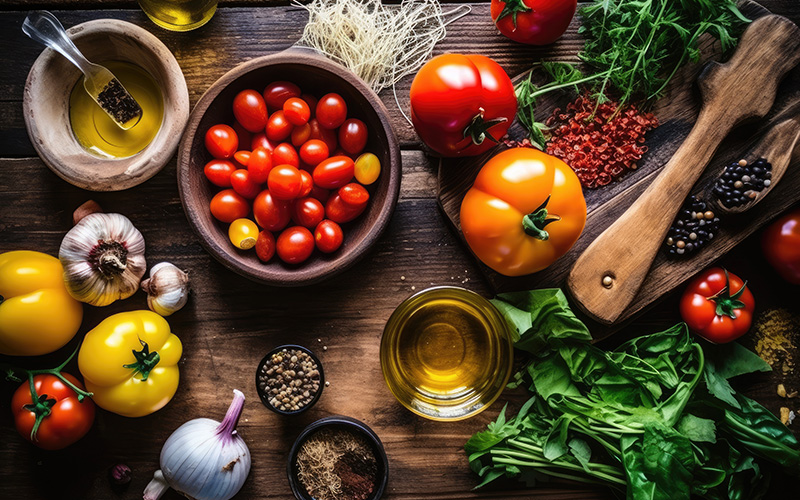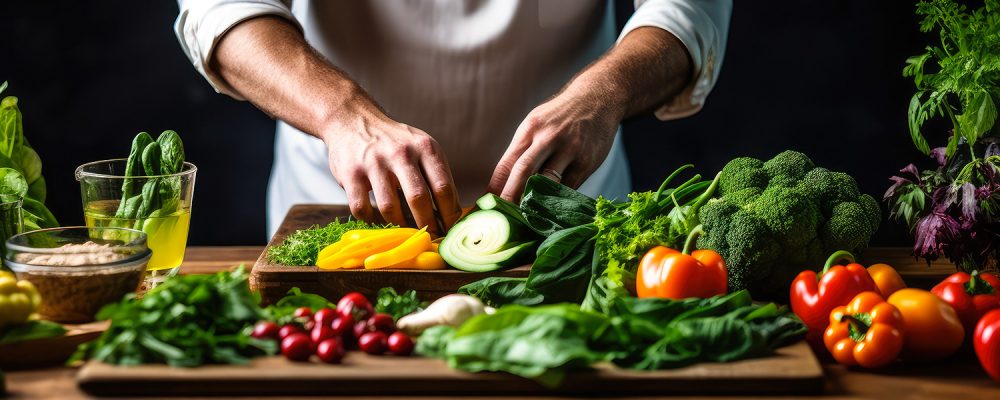What is Culinary Nutrition? Culinary nutrition is a division of the culinary arts that combines the science of food and the art of cooking to create wholesome, nutritious meals.
For example, a chef who has a degree in culinary nutrition will take a more holistic approach to the meals they create. They do this by taking into consideration the nutrients of the foods they’re using in a recipe as well as how those nutrients might be altered in the way they’re cooked or enhanced by the way they’re prepared.
Why Is Culinary Nutrition Important?
We may know what foods are good for us, but we don’t always know how to prepare them in the most healthy ways. Having some basic knowledge of culinary nutrition allows us to make smart food choices. It can also help us combine ingredients in a balanced way and tailor our meals to suit specific dietary needs.
How Does Cooking Affect the Nutrients in Food?

It’s important to note that, in culinary nutrition, making healthier, more nutrient-dense meals depends a lot on knowing how certain cooking techniques can affect the nutritional value of your food.
Here’s a breakdown of some popular cooking techniques and how they can affect the nutritional value of your foods:
Boiling, Simmering, and Poaching
Boiling, simmering, and poaching are some of the common techniques that involve cooking food in hot water. These methods can cause water-soluble vitamins like vitamin C and some B vitamins to leach out into the water. However, they are gentle on foods and can reduce the fat content in meats. For vegetables, it’s best to use minimal water and cook for a short duration to preserve nutrients.
Grilling and Broiling
Grilling and broiling use direct heat and can lead to the formation of charred spots, which may contain harmful compounds. However, these methods can reduce fat in meats as it drips away and helps retain most water-soluble vitamins and minerals. It’s important to avoid overcooking to minimize nutrient loss and potential harmful compound formation.
Microwaving
Microwaving is actually one of the best methods for preserving nutrients, as it cooks food quickly and without much water. Vitamin C retention is higher with microwaving compared to boiling. It’s a quick, convenient, and surprisingly healthy cooking method, especially for vegetables.
Roasting and Baking
Roasting and baking use dry heat and can preserve most nutrients except for some sensitive vitamins, which may be lost during prolonged cooking times. Cooking using these techniques at lower temperatures for longer durations can help save nutrients from being lost.
Sautéing and Stir-Frying
Sautéing and stir-frying involve cooking food quickly in a small amount of oil at high heat. These ways of cooking can help veggies and meats keep their texture and nutrients, especially if they are only cooked for a short time. It’s important to use good oils, like extra virgin olive oil or avocado oil, and not heat them too much.
Frying
Frying involves cooking food in a large amount of fat at a high temperature (usually oil). Foods that are fried can significantly increase the fat content, and vitamins that dissolve in water can be lost at high temperatures. On the other hand, it can help your body absorb fat-soluble vitamins and some phytonutrients that are found in some veggies.
Steaming
Lastly, another better way to cook food that keeps nutrition, especially water-soluble vitamins, is to steam it. Since the food does not come into contact with the cooking water, there’s minimal nutrient loss. Many foods, like veggies and fish, can be cooked gently and well by steaming them.
Potential Benefits of Culinary Nutrition

Many benefits may be derived from having some knowledge of culinary nutrition! Here are a few of the many perks that stand out:
Better Health and Wellness: Culinary nutrition focuses on healthy cooking methods and foods that are high in nutrients. This is very important for staying healthy and avoiding chronic diseases.
Weight Control: Learning how to cook healthy meals with natural ingredients can help you lose weight. When you eat healthy meals, which are usually more filling and high in nutrients, you can control your hunger and eat less.
Disease Prevention and Management: Knowledge of culinary nutrition can help you avoid and treat a number of health problems, like diabetes, obesity, high blood pressure, heart disease, and hypertension.
Food Knowledge and Skills: Learning more about the nutritional value of different foods and how to cook them can help a person make healthier food choices and form lifelong good eating habits.
Mental Health: Eating well can help your mental health by giving your body the nutrients it needs. Not only is cooking a creative way to relax, but it’s also good for you.
Economic Benefits: Learning how to make healthy meals at home can save you money in the long run by cutting down on the need for expensive processed foods or eating out a lot.
Sustainable Eating Habits: Whole, unprocessed foods are often emphasized in culinary nutrition. This can help people adopt more sustainable eating habits that have less of an effect on the world.
Tips to Maximize Nutrient Retention During Cooking
Knowing how to cook your foods will help maximize nutritional value. Here are some guidelines that will help you retain the nutritional content of your food as it cooks:
Use Minimal Water: When boiling or steaming, use as little water as possible. This helps reduce the loss of water-soluble vitamins (like B and C vitamins) in the cooking water.
Shorten Cooking Times: Cook foods for the shortest possible time. Overcooking can lead to significant nutrient loss, especially for delicate nutrients like vitamin C.
Cook at Lower Temperatures: High temperatures can destroy certain nutrients. Whenever possible, cook at lower temperatures to preserve vitamins and minerals.
Use the Cooking Water: If you boil vegetables, consider using the cooking water in soups or sauces to take advantage of the nutrients that may have leached into the water.
Avoid Peeling Vegetables: Many nutrients are found in or just beneath the skin of vegetables. Wash them thoroughly rather than peel them.
Cut Foods After Cooking: Cutting foods into pieces exposes more surface area to heat and water. If possible, cook them whole and then cut them up.
Use Healthy Fats: When sautéing or roasting, use healthy fats like olive oil, which can help with the absorption of fat-soluble vitamins (A, D, E, K).
Steam Rather Than Boil: Steaming is better than boiling for nutrient retention, especially for vegetables. It reduces the contact with water and preserves more vitamins and minerals.
Microwave Cooking: Microwaving is actually a good cooking method for retaining nutrients because of the short cooking time and minimal use of water.
Avoid Overheating Oils: When using oils for cooking, avoid overheating them, as this can break down beneficial compounds and produce harmful ones.
Soak Grains and Legumes: Soaking grains and legumes can reduce phytic acid, which binds minerals and reduces their absorption.
Use Fresh Ingredients: Fresh ingredients often have higher nutrient levels compared to processed or stored foods.
Incorporate Acidic Ingredients: Adding a bit of lemon juice or vinegar when cooking can help preserve vitamins.
FAQs
Is Culinary Nutrition the Same as Being a Chef?
Not exactly. While a chef focuses primarily on the taste and presentation of food, someone trained in culinary nutrition will also consider the nutritional content and health impact of the meal.
Can Culinary Nutrition Focus on Special Diets?
Indeed. Culinary nutrition can be modified to accommodate a range of dietary requirements, such as diets that are allergy-friendly, gluten-free, or vegan.
Are There Any Professional Careers in Culinary Nutrition?
A culinary nutritionist, a wellness chef, or a food service manager in a health-focused institution are all jobs that can be found in this area.
How Can I Incorporate Culinary Nutrition Into My Daily Life?
Try out some nutritious dishes first. Study up on nutrient-dense foods and try preparing them in ways that preserve their nutritional content.
RV Team
* Reviewology is in partnership or collaborates with top brands highlighted on this site, including those occupying the top ranking positions.
Additionally, we earn affiliate commissions from products showcased on this website when you make a purchase through the provided links on Amazon or the company website directly.
We appreciate your support using our links to purchase your favorite brands or newly discovered brands.
Latest updates
I Thought I’d Always Feel Tired, Fat, and Forgotten—Until This
310 Greens vs AG1
The Truth About 310 Greens: A No-Nonsense Review of This Popular Supplement
Popular
I Thought I’d Always Feel Tired, Fat, and Forgotten—Until This
310 Greens vs AG1
The Truth About 310 Greens: A No-Nonsense Review of This Popular Supplement
© 2024 Reviewology. All Rights Reserved.
